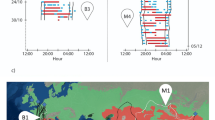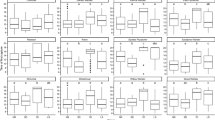Abstract
Successful migration for passerine birds depends largely on the quality of stopover habitats, but we still lack complete knowledge of how migrants search for habitats en route and how they behave when landing at poor quality stopover sites. We compared the distance of exploratory movements and stopover durations of the reed warbler Acrocephalus scirpaceus, a reedbed habitat specialist, released at suitable (reed bed) and unsuitable (sand dune) stopover sites. Birds tape-lured during nocturnal migration to a sand dune were captured, radio-tagged, released and tracked at two sites of contrasting habitat quality. Lean birds were found to move further in the dunes (max. 300 m) than in reeds (max. 200 m), whereas ‘fat’ individuals at both sites remained stationary. Birds spent just 1 day in the dunes and up to 13 days in the reeds. Our results suggest that some nocturnal migrants with restricted diurnal exploratory movements depend on stopover site selection when ceasing nocturnal flight.




Similar content being viewed by others
References
Aborn DA, Moore FR (1997) Pattern of movement by summer tanagers (Piranga rubra) during migratory stopover: a telemetry study. Behaviour 134:1077–1100
Åkesson S (1999) Do passerine migrants captured at an inland site perform temporary reverse migration in autumn? Ardea 87:129–137
Alerstam T (1978) Reoriented bird migration in coastal areas: dispersal to suitable resting grounds? Oikos 30:405–408
Alerstam T, Lindström A (1990) Optimal bird migration: the relative importance of time, energy and safety. In: Gwinner E (ed) Bird migration. Springer, Berlin, pp 331–351
Anderson DR (2008) Model based inference in the life sciences: a primer on evidence. Springer, New York, p 184
Bairlein F (1983) Habitat selection and associations of species in European passerine birds during southward, post-breeding migrations. Ornis Scand 14:239–245
Bairlein F (1988) How do migratory birds cross the Sahara? Trends Ecol Evol 8:191–194
Bairlein F (1995) Manual of Field Methods. European-African Songbird Migration Network. Wilhelmshaven, Germany http://www.ifv.terramare.de/ESF/manual.pdf Accessed 10 Aug 2009
Bairlein F (2003) Large-scale networks in bird research in Europe: pitfalls and prospects. Avian Sci 3:49–64
Barton K (2009) MuMIn: multi-model inference. R package version 0.12.2.
Bayly NJ (2006) Optimality in avian migratory fuelling behaviour: a study of a trans-Saharan migrant. Anim Behav 71:173–182
Bayly NJ (2007) Extreme fattening by sedge warblers, Acrocephalus schoenobaenus, is not triggered by food availability alone. Anim Behav 74:471–479
Bell WJ (1991) Searching behaviour: the behavioural ecology of finding resources, 1st edn. Chapman and Hall, Cambridge University Press, Cambridge
Benson AM, Winker K (2005) Fat-deposition strategies among highlatitude passerine migrants. The Auk 122:544–557
Berthold P (1996) Control of bird migration. Chapman and Hall, London
Biebach H (1985) Sahara stopover in migratory flycatchers: fat and food affect the time program. Experientia 41:695–697
Bolshakov CV, Shapoval AP, Zelenova NP (2002) Results of bird trapping and ringing by the Biological Station “Rybachy” on the Courish Spit in 2001. Avian Ecol Behav 9:67–114
Bolshakov C, Bulyuk V, Chernetsov N (2003) Spring nocturnal migration of Reed Warblers Acrocephalus scirpaceus: departure, landing and body condition. Ibis 145:106–112
Bosschieter L, Goedhart PW (2005) Gap crossing decisions by reed warblers (Acrocephalus scirpaceus) in agricultural landscapes. Land Ecol 20:455–468
Caccamise DF, Hedin RF (1985) An aerodynamic basis for selecting transmitter loads in birds. Wilson Bull 97:306–318
Chernetsov N (1998) Stopover length and weight change in juvenile reed warblers Acrocephalus scirpaceus in autumn in the Eastern Baltic. Avian Ecol Behav 1:68–75
Chernetsov N (2005) Spatial behavior of medium and long-distance migrants at stopover studied by radio tracking. Ann N Y Acad Sci 1046:242–252
Chernetsov N (2006) Habitat selection by nocturnal passerine migrants en route: mechanisms and results. J Ornithol 147:185–191
Chernetsov N, Mukhin A, Ktitorov P (2004a) Contrasting spatial behaviour of two long-distance passerine migrants at spring stopovers. Avian Ecol Behav 12:53–61
Chernetsov NS, Skutina EA, Bulyuk VN, Tsvey AL (2004b) Optimal stopover decisions of migrating birds under variable stopover quality: model predictions and the field data. Zh Obshch Biol 65:211–217
Degen T, Jenni L (1990) Biotopnutzung von Kleinvögeln in einem Naturschutzgebiet und im umliegenden Kulturland wьhrend der Herbstzugzeit. Ornithol Beob 87:295–325
Dierschke V, Mendel B, Schmaljohann H (2005) Differential timing of spring migration in northern wheatears Oenanthe oenanthe: hurried males or weak females? Behav Ecol Sociobiol 57:470–480
Delingat J, Dierschke V (2000) Habitat utilization by northern wheatears (Oenanthe oenanthe) stopping over on an offshore island during migration. Vogelwarte 40:271–278
Fransson T (1998) A feeding experiment on migratory fuelling in whitethroats Sylvia communis. Anim Behav 55:153–162
Fransson T, Barboutis C, Mellroth R, Akriotis T (2008) When and where to fuel before crossing the Sahara desert-extended stopover and migratory fuelling in first-year garden warblers Sylvia borin. J Avian Biol 39:133–138
Gavrilov EI (1980) Fall passage of Acrocephalus warblers in lower Turgai River (Kazakhstan). In: Abdusaliamov IA (ed) Bird Migration in Asia. Donish, Dushanbe, pp 227–238 (in Russian)
Giraudoux P (2009) pgirmess: Data analysis in ecology. R package version 1.4.0. http://CRAN.R-project.org/package-pgirmess
Gwinner E, Schwabl H, Schwabl-Benzinger I (1988) Effects of food-deprivation on migratory restlessness and diurnal activity in the garden warbler Sylvia borin. Oecologia 77:321–326
Harper DGC (1994) Ethics of artificially inducing landfall by migrants. Trends Ecol Evol 9(7):273
Harris RJ, Reed JM (2002) Behavioral barriers to non-migratory movements of birds. Ann Zool Fenn 39:275–290
Hedenström A (2008) Adaptations to migration in birds: behavioural strategies, morphology and scaling effects. Phil Trans R Soc B 363:287–299
Hedenström A, Alerstam T (1997) Optimum fuel loads in migratory birds: distinguishing between time and energy minimization. J Theor Biol 189(3):227–234
Herremans M (1990) Can night migrants use interspecific song recognition to assess habitat? Le Gerfaut 80:141–148
Ktitorov P, Bairlein F, Dubinin M (2008) The importance of landscape context for songbirds on migration: body mass gain is related to habitat cover. Land Ecol 23:169–179
Leisler B, Ley H-W, Winkler H (1989) Habitat, behaviour and morphology of Acrocephalus warblers: an integrated analysis. Ornis Scand 20:181–186
Lindström Ǻ (2003) Fuel deposition rates in migrating birds: causes, constraints and consequences. In: Berthold P, Gwinner E, Sonnenschein E (eds) Bird Migration. Springer, Berlin, pp 307–320
Lindström Ǻ, Hasselquist D, Bensch S, Grahn M (1990) Asymmetric contests over resources for survival and migration: a field experiment with bluethroats. Anim Behav 40:453–461
Moore FR, Aborn D (2000) Mechanisms of en route habitat selection: how do migrants make habitat decisions during stopover? Stud Avian Biol 20:34–42
Moore FR, Gauthreaux SA Jr, Kerlinger P, Simons TR (1995) Habitat requirements during migration: important link in the conservation of Neotropical landbird migrants. In: Martin T, Finch D (Eds) Ecology and Management of Neotropical Migratory Birds. Oxford University Press, Oxford pp. 121–144
Mukhin A (2004) Night movements of young reed warblers in summer—is it postfledging dispersal? Auk 121:203–209
Mukhin A, Kosarev V, Ktitorov P (2005) Nocturnal life of young songbirds long before migration. Proc Royal Soc B 272:1535–1539
Mukhin A, Chernetsov N, Kishkinev D (2008) Acoustic information as a distant cue for habitat recognition by nocturnally migrating passerines during landfall. Behav Ecol 19(4):716–723
Mukhin A, Grinkevich V, Helm B (2009) Under cover of darkness: nocturnal life of diurnal birds. J Biol Rhythms 24(3):225–231
Naef-Daenzer B (1993) A new transmitter for small animals and enhanced methods of home range analysis. J Wildl Manag 57:680–689
Nams VO (2006) Locate III User’s Guide. Pacer Computer Software, Tatamagouche, Nova Scotia, Canada http://www.locateiii.com/index.htm Accessed 19 Sen 2008
Paxton KL, Van Riper C III, O’Brien C (2008) Movement patterns and stopover ecology of Wilson’s warblers during spring migration on the Lower Colorado River in Southwestern Arizona. Condor 110:672–681
Rappole JH, Tipton AR (1991) New harness design for attachment of radio-transmitters to small passerines. J Field Ornithol 62:335–337
R Development Core Team (2009) R: a language and environment for statistical computing. R Foundation for Statistical Computing, Vienna, Austria. ISBN 3-900051-07-0, URL http://www.R-project.org Accessed 19 Jan 2010
Rguibi-Idrissi H, Julliard R, Bairlein F (2003) Variation in the stopover duration of reed warblers Acrocephalus scirpaceus in Morocco: effects of season, age and site. Ibis 145:650–656
Schaub M, Jenni L (2000) Fuel deposition of three passerine bird species along the migration route. Oecologia 122:306–317
Schaub M, Schwilch R, Jenni L (1999) Does tape-luring of migrating reed-warblers increase number of recruits or capture probability? Auk 116:1047–1053
Schaub M, Jenni L, Bairlein F (2008) Fuel stores, fuel accumulation, and the decision to depart from a migration stopover site. Behav Ecol 19:657–666
Weber T (1999) Blissful ignorance? Departure rules for migrants in a spatially heterogeneous environment. J Theor Biol 199:415–424
Wikelski M, Tarlow EM, Raim A, Diehl RH, Larkin RP, Visser GH (2003) Avian metabolism: costs of migration in free-flying songbirds. Nature 423:704
Winker K (1995) Autumn stopover on the Isthmus of Tehuantepec by woodland Nearctic–Neotropic migrants. Auk 112:690–700
Yosef R, Chernetsov N (2005) Longer is fatter: body mass changes of migrant reed warblers (Acrocephalus scirpaceus) staging at Eilat, Israel. Ostrich 76:142–147
Acknowledgements
The authors are most grateful to Casimir Bolshakov for supporting this project in many ways and the researchers of the Biological Station Rybachy for helpful discussions. Special thanks are due to Nikita Chernetsov, Julia Delingat and two anonymous reviewers for important comments on earlier drafts. Nikita Chernetsov, Anastasia Tsykalova, Martin Griffiths and Falk Huetmann gave invaluable assistance in producing the English version. Nikolay Poelplau helped with estimation of the location error; Dmitry Kishkinev, Victor Bulyuk, Vitaly Grinkevich, Dmitry Leoke and Valere Martin assisted in the field. The methods used in this study comply with the laws of the Russian Federation.
Author information
Authors and Affiliations
Corresponding author
Additional information
Communicated by W. Wiltschko
Rights and permissions
About this article
Cite this article
Ktitorov, P., Tsvey, A. & Mukhin, A. The good and the bad stopover: behaviours of migrant reed warblers at two contrasting sites. Behav Ecol Sociobiol 64, 1135–1143 (2010). https://doi.org/10.1007/s00265-010-0929-9
Received:
Revised:
Accepted:
Published:
Issue Date:
DOI: https://doi.org/10.1007/s00265-010-0929-9




